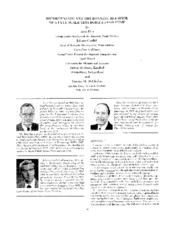| dc.description.abstract | Excessive rotor vibrations are one of the leading causes of damage to pump components, particularly to bearings, shaft seals, and premature wear of labyrinth surfaces. Under an EPRI contract which was awarded to Sulzer in 1983, a full scale three-stage test pump was built which has been extensively tested for rotordynamic behavior. Design conditions selected for this pump are typical for fossil plants with subcritical steam generation. The pump was installed in a closed loop. To investigate rotordynamic behavior experimentally, the pump had to be equipped with sophisticated instrumentation including shaft vibration measurements within the pump. The influence of different parameters such as labyrinth clearances, amount of unbalance, swirl brakes, and flowrate is described. Experimental results (i.e., unbalance response) are compared with analytical results using a rotordynamic code based on finite element approach. In boiler feed pump systems, for a number of reasons, sudden loss of suction pressure can occur. In such cases, vaporization in the pump occurs accompanied by two phase flow conditions, large hydraulic forces, loss of damping, high rotor amplitudes, with possible contact between rotor and stator. This condition was simulated with the test loop. The influence of such a loss of suction incident on pump behavior, especially shaft vibrations, is described. The conclusions highlight the importance of the labyrinths on rotordynamic behavior, in particular the influence of swirl brakes to reduce shaft vibration amplitudes. If the analytical results have to compare well with measured vibrations, excellent quantitative knowledge of bearing, labyrinth and impeller interaction dynamic coefficients is essential. | en |


